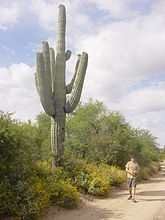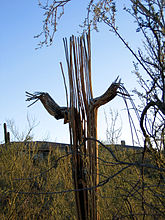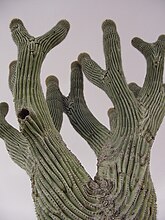Saguaro
| Saguaro | |
|---|---|
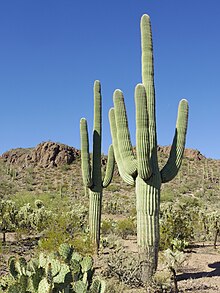
| |
| Scientific classification | |
| Kingdom: | Plantae |
| Clade: | Tracheophytes |
| Clade: | Angiosperms |
| Clade: | Eudicots |
| Order: | Caryophyllales |
| Family: | Cactaceae |
| Subfamily: | Cactoideae |
| Tribe: | Echinocereeae |
| Genus: | Carnegiea Britton & Rose |
| Species: | C. gigantea
|
| Binomial name | |
| Carnegiea gigantea (Engelm.) Britton & Rose
| |

| |
| Natural range of Carnegiea gigantea | |
| Synonyms[2] | |
| |
The saguaro (/səˈwɑːroʊ/, Spanish pronunciation: [saˈɣwaɾo]) (Carnegiea gigantea) is an arborescent (tree-like) cactus species in the monotypic genus Carnegiea, which can grow to be over 40 feet (12 m) tall. It is native to the Sonoran Desert in Arizona, the Mexican State of Sonora, and the Whipple Mountains and Imperial County areas of California. The saguaro blossom is the state wildflower of Arizona. Its scientific name is given in honor of Andrew Carnegie. In 1994, Saguaro National Park, near Tucson, Arizona, was designated to help protect this species and its habitat.
The image of the saguaro is indelibly linked with that of the American Southwest, especially in western films. The common name saguaro came into the English language through the Spanish language, originating in the Mayo language.


Saguaros have a relatively long lifespan, often exceeding 150 years. They may grow their first side arm any time from 75–100 years of age, but some never grow any arms. A saguaro without arms is called a spear. Arms are developed to increase the plant's reproductive capacity, as more apices lead to more flowers and fruit.
The growth rate of saguaros is strongly dependent on precipitation; saguaros in drier western Arizona grow only half as fast as those in and around Tucson. Saguaros grow slowly from seed, never from cuttings, and grow to be over 40 feet (12.2 metres) in height.[3] The largest known living saguaro is the Champion Saguaro growing in Maricopa County, Arizona, measuring 45.3 feet (13.8 metres) high with a girth of 10 feet (3.1 metres). The tallest saguaro ever measured was an armless specimen found near Cave Creek, Arizona. It was 78 feet (23.8 metres) in height before it was toppled in 1986 by a windstorm.[4]
A saguaro is able to absorb and store considerable amounts of rainwater, visibly expanding in the process, while slowly using the stored water as needed. This characteristic enables the saguaro to survive during periods of drought.
When rain is plentiful and the saguaro is fully hydrated it can weigh between 3,200–4,800 pounds (1,500–2,200 kg).
Genome
This section needs expansion. You can help by adding to it. (April 2018) |
The saguaro genome is around 1 billion base pairs long.[5] Sequencing has revealed that the genome of the saguaro's chloroplast is the smallest known among non-parasitic flowering plants.[6]
Spines
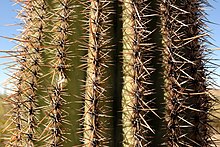
The spines on a saguaro can grow up to 1 millimetre (0.039 in) per day. When held up to the light or bisected, alternating light and dark bands transverse to the long axis of spines can be seen. These transverse bands have been correlated to daily growth. In columnar cacti, spines almost always grow in areoles which originate at the apex of the plant. A spine stops growing in its first season. Areoles are moved to the side and the apex continues to grow upwards. Thus, older spines are towards the base of a columnar cactus and newer spines are near the apex. Studies are underway to examine the relationship of carbon and oxygen isotope ratios in the tissues of spines of an individual to its climate and photosynthetic history (acanthochronology).[7]
Flowers

Flowers appear in April through June. They are white and open well after sunset and close in mid-afternoon. They continue to produce nectar after sunrise.[8] Flowers are self-incompatible, thus require cross-pollination. Large quantities of pollen are required for complete pollination because many ovules are present. This pollen is produced by the extremely numerous stamens which in one case totaled 3,482 in a single flower.[9] A well-pollinated fruit contains several thousand tiny seeds. Saguaros have a redundant pollination system, i.e. full fruit set is possible even if only a fraction of the pollinating species are present.
Main pollinators are honey bees, bats, and white-winged doves. In most years, diurnal visitors are the main contributors for fruit, most of them honey bees. Other diurnal pollinators are birds such as Costa's hummingbird, the black-chinned hummingbird, the broad-billed hummingbird, the hooded oriole, Scott's oriole, the Gila woodpecker, the gilded flicker, the verdin, and the house finch.[10]
The main nocturnal pollinator is the lesser long-nosed bat, feeding on the nectar. A number of floral characteristics are geared toward bat pollination: nocturnal opening of the flowers, nocturnal maturation of pollen, very rich nectar, position high above ground, durable blooms that can withstand a bat's weight, and fragrance emitted at night. Further, the amino acids in the pollen appear to help sustain lactation in bats.
Fruit


The ruby red fruits are 2.4 to 3.5 inches (6 to 9 cm) long and ripen in June. Each fruit contains around 2,000 seeds plus sweet fleshy connective tissue. The fruits are edible and prized by local people.
The fruits cannot be picked by hand, but must be harvested using a pole (often a saguaro rib) 7 to 16 feet (2 to 5 m) long, to the end of which is attached another pole.
The O'odham tribes have a long history of saguaro fruit use.[11] The Tohono O’odham tribes celebrate the beginning of their summer growing season with a ceremony using a fermented drink made from the bright red fruit to summon rains, vital for the crops.
Nests
Native birds such as Gila woodpeckers, purple martins, house finches, and gilded flickers live inside holes in saguaros. Flickers excavate larger holes higher on the stem.[12] The nest cavity is deep, and the parents and young are entirely hidden from view. The saguaro creates callus tissue on the wound. When the saguaro dies and its soft flesh rots, the callus remains as a so-called saguaro boot, which was used by natives for storage.
The Gila woodpeckers (Melanerpes uropygialis) create new nest holes each season rather than reuse the old ones, leaving convenient nest holes for other birds, such as elf owls, flycatchers, and wrens.[13] In recent years, early-breeding, aggressive, non-native birds have taken over the nests to the detriment of elf owls that breed and nest later.
Laws
Harming a saguaro in any manner, including cactus plugging, is illegal by state law in Arizona, and when houses or highways are built, special permits must be obtained to move or destroy any saguaro affected.[14] Exceptions to this general understanding exist; for example, a private landowner whose property is 10 acres (4.0 ha) or less, where the initial construction has already occurred, may remove a saguaro from the property.[15] This is common when the cactus falls over in a storm, its location interferes with a house addition, or it becomes a potential hazard to humans.[16]
Contrary to published statements,[17] there is no law mandating prison sentences of 25 years for cutting a cactus down; however it is considered a class four felony with a possible 3 year, 9 month maximum sentence.[18]
Ethnobotany
- The saguaro is an important source of food and shelter for the Tohono O’odham. Saguaro spines are sometimes used as sewing needles and the ribs are used to make harvesting tools.
- The ribs of the saguaro were used for construction and other purposes by Native Americans. A fine example can be seen in the roofing of the cloisters of the Mission San Xavier del Bac on the Tohono O'odham lands near Tucson.
- The Seri people of northwestern Mexico used the plant, which they call mojépe, for a number of purposes.
Location and imagery
The saguaro is often used as an emblem in commercials and logos that attempt to convey a sense of the Southwest, even if the product has no connection to Arizona or the Sonoran Desert. For instance, no naturally occurring saguaros are found within 250 miles (400 km) of El Paso, Texas, but the silhouette is found on the label of Old El Paso brand products.[19][20] Though the geographic anomaly has lessened in recent years, Western films once enthusiastically placed saguaros in the Monument Valley of Arizona, as well as New Mexico, Utah, and Texas. The Dallas, Texas-based band, Reverend Horton Heat, pokes fun at this phenomenon in their song "Ain't no Saguaro in Texas".[21] No wild saguaros are found anywhere in New Mexico, Texas, Colorado, Utah, or Nevada, nor in the high deserts of northern Arizona.[20]
Gallery
-
Saguaro silhouette at sunset
-
Saguaro towering over a 6-ft man
-
Mature five-armed in flower
-
Snow-covered saguaro near Tucson. Saguaros can survive a few hours of below-freezing temperature.
-
Needles of a saguaro, Paradise Valley, Arizona
-
Saguaro flowers, Scottsdale, Arizona
-
The bare wooden ribs of a dead saguaro
-
Unusually-formed crested or cristate saguaro near Kino Bay, Sonora
References
Notes
- ^ Burquez Montijo, A., Butterworth, C., Baker, M. & Felger, R.S. (2013). Carnegiea gigantea. The IUCN Red List of Threatened Species. Version 2014.2.
- ^ "Carnegiea gigantea (Engelm.) Britton & Rose". Tropicos. Missouri Botanical Garden. Retrieved 2014-09-19.
- ^ "Life Cycle of the Saguaro" (PDF). Arizona-Sonora Desert Museum. 2008. Retrieved 2013-12-04.
- ^ "Windstorm Fells 78-Foot Cactus--Tallest in World". Retrieved 2015-08-04.
- ^ "SGP5_Cgig_v1.3 - Genome - Assembly - NCBI". www.ncbi.nlm.nih.gov. Retrieved 24 April 2018.
- ^ Sanderson, Michael J.; Copetti, Dario; Búrquez, Alberto; Bustamante, Enriquena; Charboneau, Joseph L. M.; Eguiarte, Luis E.; Kumar, Sudhir; Lee, Hyun Oh; Lee, Junki (2015-07-01). "Exceptional reduction of the plastid genome of saguaro cactus (Carnegiea gigantea): Loss of the ndh gene suite and inverted repeat". American Journal of Botany. 102 (7): 1115–1127. doi:10.3732/ajb.1500184. ISSN 0002-9122. PMID 26199368.
- ^ English, N. B.; Dettman, D. L.; Sandquist, D. R.; Williams, D. G. (2007). "Past climate changes and ecophysiological responses recorded in the isotope ratios of saguaro cactus spines". Oecologia. 154 (2): 247. doi:10.1007/s00442-007-0832-x.
- ^ Theodore H. Fleming: Sonoran desert columnar cacti and the evolution of generalized pollination systems. In: Ecological Monographs. Band 71, Number 4, 2001, pp. 511–530, JSTOR.
- ^ SCIENCE Vol. 40 (November 6, 1914) p. 680.
- ^ Theodore H. Fleming: Sonoran desert columnar cacti and the evolution of generalized pollination systems. In: Ecological Monographs. Band 71, Number 4, 2001, pp. 517–518, JSTOR.
- ^ A Natural History of the Sonoran Desert, Edited by Steven J Phillips and Patricia Comus, University of California Press, Berkeley, 2000, p. 193
- ^ Mark Elbroch; Eleanor Marie Marks; C. Diane Boretos (2001). Bird tracks and sign. Stackpole Books. p. 311. ISBN 0-8117-2696-7.
Cavities in saguaro cactuses in the Southwest are common. Both gilded flickers and Gila woodpeckers make these cavities for nesting, but they often choose different locations on the cactus. The stouter bills of the gilded flickers allow them to cut cavities through the wooden ribs near the top of the cactus where the ribs converge. Gila woodpeckers stay at midlevel on the cactus where the ribs are separated enough to cut a cavity between them. Cavities in saguaros are cut out by these birds the year before they are inhabited. The excavated cactus secretes a fluid that hardens into a scab, thus preventing water loss, which could kill the cactus, as well as waterproofing the inside of the next cavity.
- ^ "Gila woodpecker". Nature Conservancy. Retrieved 2011-01-24.
Although they do not use them immediately, waiting first for the sap to harden, Gila woodpeckers excavate cavities in cacti and trees as nesting sites. Females typically lay two broods a year of three to five eggs, which incubate for 14 days. Once abandoned, the cavities are occupied by reptiles, rodents, and small birds like kestrels, elf owls, flycatchers, and wrens. In the desert, the woodpeckers perform the important ecological function of removing unhealthy flesh from the saguaro cactus. Some insects on which it feeds carry diseases, harmless to the bird, which damage the cactus and leave discolorations. The marks signal larvae to the bird, and as it excavates the insects, it also cuts away the diseased tissue. As the sap hardens, the cactus is healed, and the excavation becomes a convenient nesting site.
- ^ "Article 11: Arizona Native Plants". Arizona Department of Agriculture. Archived from the original on September 20, 2013.
{{cite web}}: Unknown parameter|deadurl=ignored (|url-status=suggested) (help) - ^ "<unknown>" (PDF). Arizona Department of Agriculture. Archived from the original (PDF) on September 20, 2013.
{{cite web}}: Cite uses generic title (help); Unknown parameter|deadurl=ignored (|url-status=suggested) (help) - ^ "Arizona Revised Statutes, A.R.S. 3-904.(H): Destruction of protected plants by private landowners; notice; exception". Arizona State Legislature.
- ^ Trimble, Marshall (2012). "Only On Hold Strange Laws Still On The Books In Arizona". Tucson News Now. Hold. Retrieved July 2, 2017.
- ^ Snyder, Stephanie (2010). "Safety of native plants protected under Arizona law". ASU.edu. Chevas Samuels, McKenzie Manning, Stephanie Snyder. Retrieved July 2, 2017.
"While damaging a cactus in Arizona will not warrant the rumored possibility of 25 years in prison, it is still considered a class four felony."
- ^ Inc., General Mills. "Cooking Ideas from Old El Paso". www.oldelpaso.com. Retrieved 24 April 2018.
{{cite web}}:|last=has generic name (help) - ^ a b "Where Saguaros Grow - Saguaro National Park (U.S. National Park Service)". www.nps.gov. Retrieved 24 April 2018.
- ^ Yep Roc Records (11 March 2015). "Reverend Horton Heat - "Ain't No Saguaro in Texas" (Official Audio)". Retrieved 24 April 2018 – via YouTube.
This article needs additional citations for verification. (December 2014) |
Bibliography
- Benson, L. (1981). The Cacti of Arizona. University of Arizona Press. ISBN 0-8165-0509-8.
- Drezner TD (2005) Saguaro (Carnegiea gigantea, Cactaceae) growth rate over its American range and the link to summer precipitation. Southwest Nat 50:65–68.
- Felger, Richard; Mary B. Moser. (1985). People of the desert and sea: ethnobotany of the Seri Indians. Tucson: University of Arizona Press.
External links
- IUCN Red List least concern species
- Pachycereeae
- Cacti of Mexico
- Cacti of the United States
- Flora of the Sonoran Deserts
- Flora of Arizona
- Flora of Sonora
- Flora of the California desert regions
- Flora of Northwestern Mexico
- Flora of the Southwestern United States
- North American desert flora
- Natural history of the Colorado Desert
- Least concern flora of North America
- Least concern flora of the United States
- Symbols of Arizona
- Plants used in Native American cuisine
- Plants used in traditional Native American medicine
- Desert fruits
- Edible plants
- Garden plants of North America
- Drought-tolerant plants



